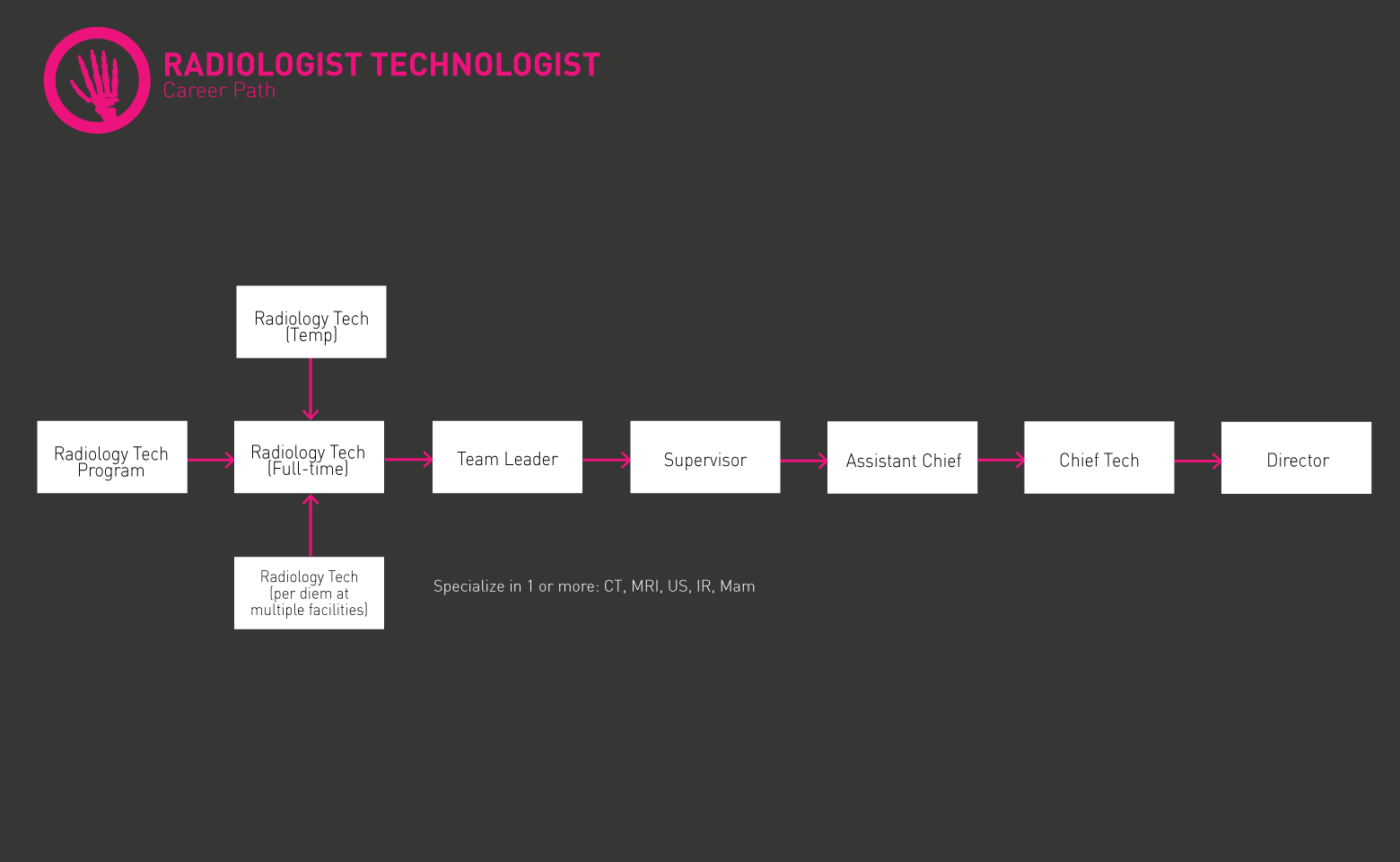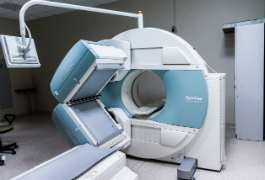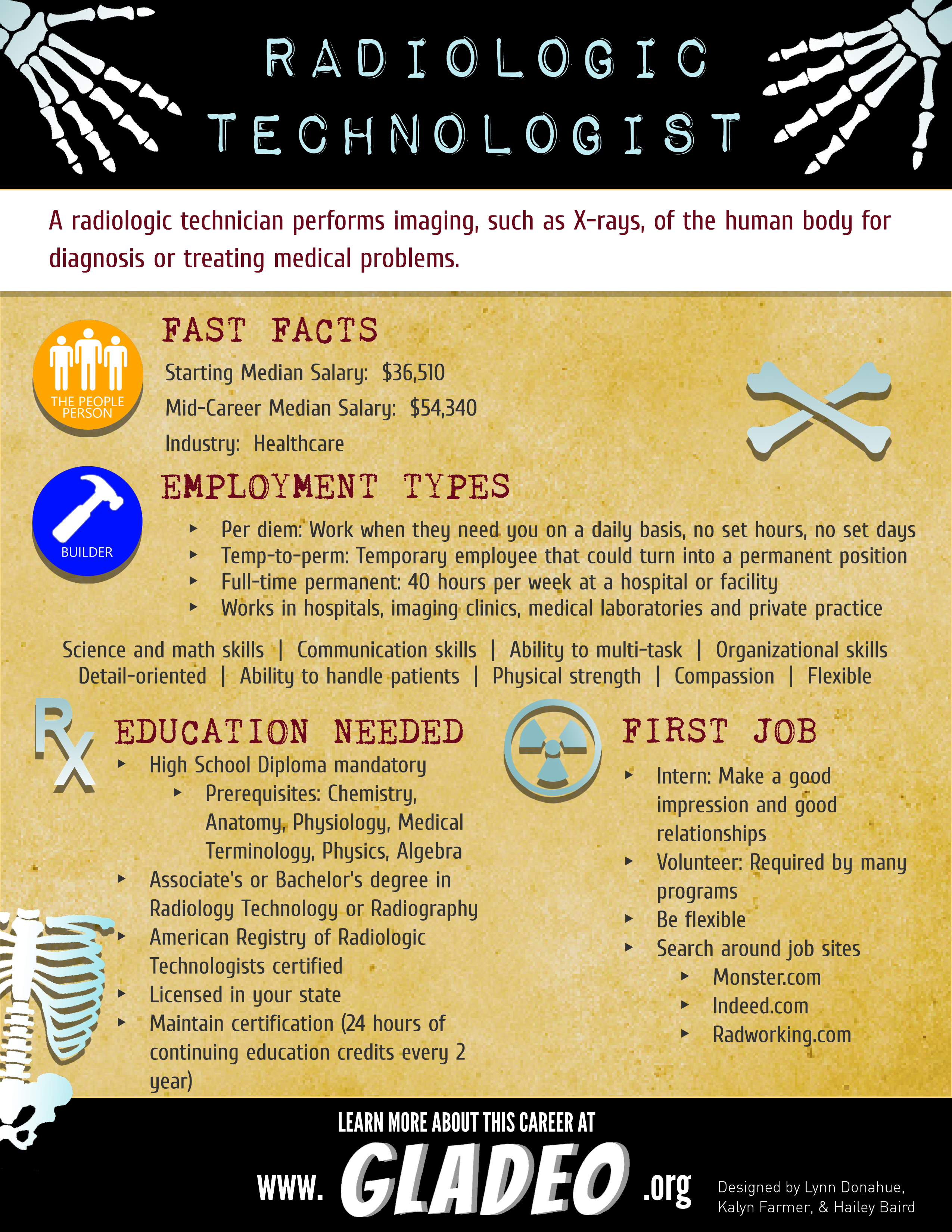Spotlights
Radiology Technician, Imaging Technician, X-Ray Technician, Radiographer, CT Technician, MRI Technician, Mammographer
A radiologic technician performs imaging, such as X-rays, of the human body for diagnosis or treating medical problems.
A radiologic technologist is a radiology technician that specializes in one of more of the following modalities: Computerized tomography (CT) scan, Magnetic resonance imaging (MRI), mammography, bone densitometry, and fluoroscopes (imaging of various soft tissues within the body).
- Getting to help people!
- Good pay
- Job security
- Prepares patients for exams, explains the x-ray procedure, preps patients properly for the x-ray, and positions patients so that the correct part of the body can be radiographed.
- Takes the x-rays, develops them, and passes them along to a radiologist (a physician who interprets radiographs) for diagnosis.
- Performs arthrograms - assisting the radiologist with injecting contrast or dye into joints for evaluation. Performs myelograms - assisting the radiologist with injecting contrast into the spinal canal.
- Keeps patient records and adjust and maintains equipment. They also may prepare work schedules, evaluate equipment purchases or manage a radiology department.
- Communication skills
- Patient handling: Must be able to calm the patient through the process.
- Physical strength: Work on your feet and must assist and lift patients who need help.
- Detail-oriented
- Science and math skills
- Compassion: passion for a patient’s well-being.
- Ability to multi-task
- Organizational skills
- Flexible: It is not always the way it is as shown in the books. Must be able to modify each exam to fit the needs of different patient’s limitations.
- Per diem: Work when they need you on a daily basis, no set hours, no set days.
- Temp-to-perm: Temporary employee that could turn into a permanent position.
- Full-time permanent: 40 hours per week at a hospital or facility.
- Works in hospitals, imaging clinics, medical laboratories and private practice.
- Schedules constantly change at most facilities.
- Work weekends and holidays.
- Shift work: days, evenings and graveyard (overnight) shift.
- Not much upward mobility without bachelors or masters degree.
Current graduating students might have to get multiple per diem jobs and then one of them might become a full time position at one of the facilities. There are not a lot of full time positions for new graduates but there are many different options to get in the door, just not the traditional full-time positions.
“I was a very active child. I did not spend much time indoors. I rode bikes with neighborhood kids, played soccer, did Greek dancing, cheerleading, competitive swimming, basketball, softball, hiking, and camping. I'm not able to sit still for very long, so a desk job was not an option for me. I need to be on my feet and constantly moving around to keep myself stimulated and alert.” Ashley, X-ray Technician
- Radiologic Technologists usually hold an associate’s degree in their field. Some go on to become MRI Technologists
- Academic programs should be accredited by the Joint Review Committee on Education in Radiologic Technology
- Most states require licensure or certification via a state exam or from a credentialing agency, such as the American Registry of Radiologic Technologists. ARRT offers 15 credential options in:
- Bone Densitometry
- Breast Sonography
- Cardiac Interventional Radiography
- Cardiovascular Interventional Radiography
- Computed Tomography
- Magnetic Resonance Imaging
- Mammography
- Nuclear Medicine Technology
- Quality Management
- Radiation Therapy
- Radiography
- Registered Radiologist Assistant
- Sonography
- Vascular Interventional Radiography
- Vascular Sonography
- Additional national certifications are listed on O*Net and may require education and experiential backgrounds. Examples include:
- American Board of Imaging Informatics - Certified Imaging Informatics Professional
- American Board of Medical Physics -
- Certification in Magnetic Resonance Imaging Physics
- Certification in Medical Health Physics
- American Board of Science in Nuclear Medicine - Certification in Radiation Protection
- American Chiropractic Registry of Radiologic Technologists - Certified Radiological Technologist
- American College of Chest Physicians - Certificate of Completion - Critical Care Ultrasonography
- American Medical Certification Association - EKG Technician Certification
- American Registry of Diagnostic Medical Sonographers - Sonography Principles and Instrumentation
- American Registry of Magnetic Resonance Imaging Technologists - Magnetic Resonance Imaging Technologist
- American Society for Nondestructive Testing - Industrial Radiography Radiation Safety Personnel - X-Ray
- Association for Medical Imaging Management - Certified Radiology Administrator
- Certification Board for Radiology Practitioner Assistants - Radiology Practitioner Assistant
- International Society for Clinical Densitometry - Certified Bone Densitometry Technologist
- Nuclear Medicine Technology Certification Board -
- Positron Emission Tomography
- Nuclear Cardiology Technologist
- PACS Administrators Registry and Certification Association - Certified PACS Associate
- Vascular Access Certification Corporation - Vascular Access-Board Certified
- Take college prep classes in high school, including biology, chemistry, math, and physics
- Associate degree courses include:
- Basic Radiographic Procedures
- Clinical Medical Radiologic Technology
- Intermed Radiographic Procedures
- Introduction to Radiography and Patient Care
- Intro to Anatomy and Physiology
- Principles Radiographic Imaging
- Radiation Biology and Protection
- Radiographic Imaging Equipment
- Radiographic Pathology
- Make a good impression during internships, which might lead to future full-time work!
- Ask a working Radiologic Technologist if you can do an informational interview with them
- Review job ads to learn more about the qualifications local employers are looking for
- Consider volunteering with local healthcare-related community organizations, to boost your resume
- To become radiologic technologist: Need more certifications in the modalities you want to pursue.
- To be a manager: Need a bachelor’s degree.
- 9% with HS Diploma
- 45% with Associate’s
- 19.4% with Bachelor’s
- 2.2% with Master’s
- 2.3% with Doctoral

- Intern!: While you are a student, you will have an opportunity to intern at multiple facilities. During your clinical rotations, you should make a good impression and make good relationships. Even if you do not get hired at the hospital you intern at, the hospitals communicate with each other and internships are good on your resume.
- Volunteer: A lot of the programs are not requiring applicants to do volunteer hours in order to get a feel for the hospital setting. Do as many volunteer hours as possible because you will have a good opportunity to network and show your professionalism, get a reference and eventually a job.
- Be flexible: Might start off as a per-diem employee or temporary employee, make a good impression and they might hire you as a full-time employee.
- After completing your education, apply for state licensure or certification, as needed
- Reach out to applicable organizations if you have any questions or need help
- Considering getting multiple certifications so you can enhance your credentials
- Build strong connections while doing internships. Keep an eye open for job opportunities
- Look for jobs and internships on Indeed, Simply Hired, Glassdoor, or other popular job portals
- Ask your professors and your school’s alumni network for job-seeking tips
- Find out if your school offers job placement assistance or other valuable career services such as help with resume writing or interview practice
- If needed, relocate to where the highest concentration of Radiologic Technologist jobs are — West Virginia, South Dakota, North Dakota, Mississippi, and Kentucky. Note, the highest employment levels are in California, Texas, New York, Florida, and Pennsylvania
- Check out Radiologic Technologist resume templates for ideas on formatting and phrasing
- Study common Radiologic Technologist interview questions to help prepare your responses
- More certifications/specializations you have, the more employable you are: CT (on the job training), MRI (on the job training), mammography (additional schooling), ultrasound (additional schooling, separate license)…etc.
- Attend conferences.
Websites
- American Board of Imaging Informatics
- American Board of Medical Physics
- American Board of Science in Nuclear Medicine
- American Chiropractic Registry of Radiologic Technologists
- American College of Chest Physicians
- American Medical Certification Association
- American Registry of Diagnostic Medical Sonographers
- American Registry of Magnetic Resonance Imaging Technologists
- American Registry of Radiologic Technologists
- American Society for Nondestructive Testing
- American Society of Radiologic Technologists
- Association for Medical Imaging Management
- Certification Board for Radiology Practitioner Assistants
- International Society for Clinical Densitometry
- Joint Review Committee on Education in Radiologic Technology
- Nuclear Medicine Technology Certification Board
- PACS Administrators Registry and Certification Association
- Vascular Access Certification Corporation
Books
- Bontrager's Textbook of Radiographic Positioning and Related Anatomy, by John Lampignano MEd RT and Leslie E. Kendrick MS RT
- Essentials of Radiologic Science, by Denise Orth MS RT
- Radiologic Science for Technologists: Physics, Biology, and Protection, by Stewart C. Bushong ScD FAAPM FACR
Alternate careers: Instructor or director in radiologic technology programs, Sales representatives or instructors with equipment manufacturers, Radiation therapists (more certification), Sonographers (more certification).
Newsfeed

Featured Jobs

Online Courses and Tools

Annual Salary Expectations
New workers start around $108K. Median pay is $130K per year. Highly experienced workers can earn around $160K.
Annual Salary Expectations
New workers start around $75K. Median pay is $107K per year. Highly experienced workers can earn around $112K.
Annual Salary Expectations
New workers start around $106K. Median pay is $131K per year. Highly experienced workers can earn around $166K.
Annual Salary Expectations
New workers start around $79K. Median pay is $102K per year. Highly experienced workers can earn around $128K.







